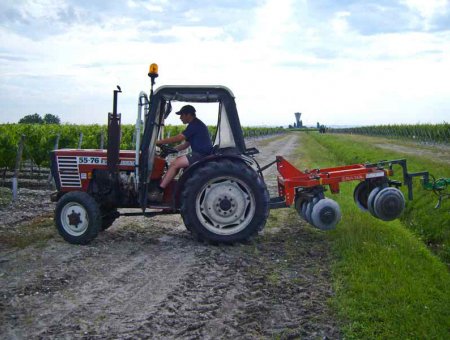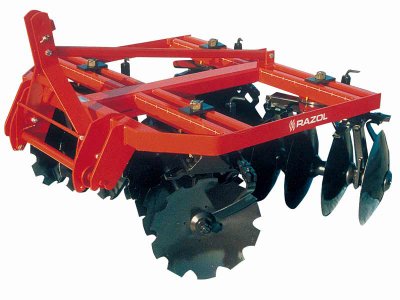Disc harrow
Le pulvérisateur à disques, composé de quatre arbres avec des disques en X, limite les réactions sur le tracteur et permet un bon travail du sol. Il se compose d'un châssis robuste, de paliers en fonte et de disques crénelés ou lisses de différents diamètres, disposés en train pour équilibrer la pénétration. La profondeur de travail et l'angle d'attaque des disques, ajustés par les bras de relevage du tracteur, déterminent la qualité du travail, affectée aussi par la vitesse d'avancement. Utilisé pour défrichage, l'entretien du couvert végétal et l'émiettement, il s'attelle sur divers types de tracteurs pour une performance optimale.

Working target

Composed of four shafts with discs arranged in an X shape, they do not generate any reaction on the tractor because the angles are symmetrical, but can cause problems with the quality of work in the machine's axis.
The adjustment of the angles determines the working depth and the movement of the soil; the forward speed also has a major influence on these two parameters.
Disc harrow components
The frame
Made up of welded square sections, the thickness of which varies from 6 to 8 mm. It ensures the rigidity of the tool. It holds one or more sets of discs. There are two main types of disc harrow: X and V discs.The shaft
There are 2 or 4 shafts. They are square in cross-section and vary in diameter from 30 to 40 mm.The bearing
Generally made of cast iron, the bearings allow the disc train to rotate. Manufacturers offer bearings with or without ball bearings. The latter are conical or double-row ball bearings. If the bearings are fitted, Grégoire Besson installs 4 outward-facing seals to allow excess grease to escape while protecting the bearing.Discs
2 models are widely used, the serrated and the smooth. Numerous diameters are available, with the most commonly used in viticulture varying between 510 and 560 mm.The disc train
Each disc train is made up of a combination of serrated or smooth discs. In general, the serrated discs are located on the front disc trains and the smooth discs at the rear, in order to balance the penetration capacity between the two disc trains.Adjusting and using the disc harrow
Setting
Working depth
First of all, the working depth, which varies according to soil conditions and the characteristics of the tool (weight of the tool, spacing and shape of the discs). In general, depth is adjusted using the tractor's lifting arms, supplemented by the equipment on the tool itself (rear roller or gauge wheel).Angle of attack of disc trains and forward speed
The working quality of a disc harrow depends on the angle of attack of the disc trains and the forward speed. Theangle of attack (orientation of the disc train in relation to the row axis) can vary from 10° to 25° depending on the model.A high angle of attack means that the soil is turned over and weeds are buried more deeply.
The role of the first row of discs is to lift a superficial layer of soil, while the second row of discs picks up the soil, continues its dislocation and throws it either under the row or into the inter-row space, depending on the position of the discs. On light soil, in summer, the use of a disc harrow with rear discs pointing towards the row can replace light shoeing. Dethatching can be carried out using a plough or alternative methods (rotary or blade inter-row ploughs).
On high-clearance tractors, there are often two sets of discs behind the rear wheels of the tractor, whose role is to return the soil to the furrow left by the passing tractor wheel. This technique provides satisfactory levelling of the inter-row.
Speed
The forward speed must be adapted: too slow and the soil scattering effect will be weak, too fast and the disc may swing sideways and affect the quality of the work.Use
The disc harrow is a trailed tool that can be used for the main soil-working operations:- land clearing
- maintenance of plant cover after ploughing
- crumbling
On an inter-row tractor, it is attached to the lifting arms.
If the tool is used with a three-point linkage, it is preferable to leave a slight lateral clearance on the lifting arms. When the disc harrow is correctly adjusted, it works in line with the tractor.
A number of parameters need to be taken into account to adjust a disc harrow correctly.












